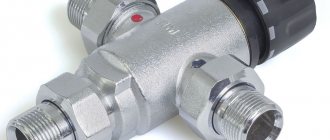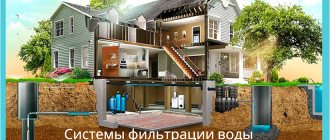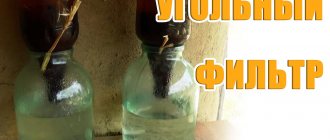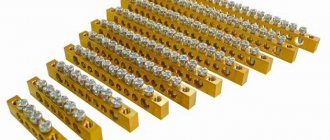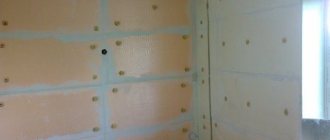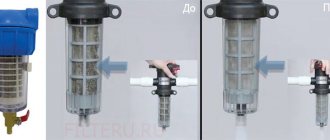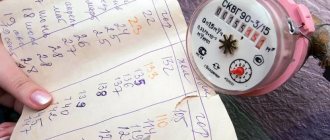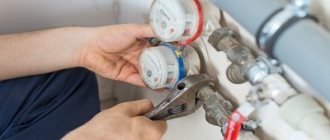With proper installation of the water meter and normal operation of the water supply system, the liquid moves in the intended direction. However, situations are possible when, for some reason, the water flow begins to move in the opposite direction. This situation is especially true for apartment buildings.
According to the principle of communicating vessels, when the pressure in certain areas of the overall system decreases, a reverse flow of water flow is possible. To eliminate incorrect operation of the water meter and possible technical malfunction in this situation, a check valve is used.
Design
A non-return valve is an automatic device that prevents the flow of liquid in the water supply in the opposite direction. In relation to a water consumption meter, this element can be used:
- as a separate node;
- as a structural part of the water meter.
A water meter additionally equipped with a check valve is more difficult to repair and less reliable due to the complexity of the design. But such a device facilitates the assembly of the finished unit - there is no need to install additional elements.
Using a check valve as an additional element is preferable, since if it fails, it can be individually replaced or repaired without dismantling the meter.
Is it necessary to install: legal requirements
There are discussions online on thematic forums about the need to comply with the requirements of management companies for the installation of metering devices and related fittings.
The confusion is caused by the fact that three documents are available for review:
- SNiP 2.04.01-85;
- SP 30.13330.2012;
- SP 30.13330.2016.
The documents are called the same: “Internal water supply and sewerage of buildings.” Despite the similarities, upon careful reading you can see differences in the issue regarding the installation of check valves. In addition, commentators do not always understand what equipment they are talking about.
Today, when installing a water supply system, the Code of Rules (SP) 30.13330.2016 applies.
In clause 1.1. it is expressly stated for which objects and when the requirements are applicable, namely:
- for the design of internal water supply at newly constructed facilities;
- for designing networks of reconstructed objects.
The objects include public buildings up to 55 meters high and residential buildings no higher than 75 meters. Government Decree No. 354 “On the provision of public services...” does not provide a direct indication of the owner’s obligation to install the device.
Where is it installed?
The composition of the equipment that is installed in internal water supply networks is discussed in Section 7 of SP 13. 30.13330.2016 . Management companies often refer to clause 7.1.4, which lists all devices that can be used.
Further paragraphs of the document list the exact installation locations. It is paragraph 7.1.9 that is devoted to check valves that install:
- on water pipelines supplying liquid to group mixers;
- on the circulating water supply.
Faucets located in apartments, even if there are a large number of them, are not grouped . In group devices, cold and hot water are mixed to the desired temperature in a separate container and only then supplied to the tap.
Hot water circulation pipelines belong to common property, so these points cannot justify the obligation to install a check valve in apartments.
Clause 7.2.1. In conjunction with the meter, it provides for the installation of check valves on the supply and circulation water pipes. But upon careful reading of the entire clause, it becomes clear that the requirements apply to the entrances to the building, and not for an individual apartment .
On what basis may installation be required?
The only clause of SP 13.13330.2016, on the basis of which they can require and achieve the installation of check valves, is the requirements of clause 7.2.11.
It says that the use of meters in sets with a built-in check valve, as well as the installation of additional protection against manipulation of readings, can be carried out at the request of the supplying organization.
Two conditions are important in this paragraph:
- the organization must supply water directly to the subscriber;
- requirements must be agreed with local authorities.
In each specific case, it is necessary to familiarize yourself with local legislation in order to decide whether or not to fight with the supplier over an “extra” device.
In Moscow, for example, the procedure for paying for devices and installation is determined by a separate Law No. 35 of July 5, 2006. Lawsuits addressing the need for check valves to one degree or another are not uncommon.
For example, you can look at Appeal Determination No. 12-27/2014 dated August 12, 2014 in case No. 12-27/2014, in which the judge clearly indicated the illegality of the supply organization’s requirement to install equipment.
What can the supply organization do?
The metering unit should be equipped in accordance with the technical specifications and the design, which will include a check valve. In addition to newly designed and reconstructed objects, any apartment can be included in the list.
In Government Decree N 776 of September 4, 2013 “On approval of the rules of commercial accounting...” there is clause 49, according to which the metering unit can be recognized as out of order.
For example, in these:
- the meter stopped displaying readings;
- there are signs of unauthorized interference in the operation of metering devices;
- seals are broken;
- mechanical damage to devices, etc.
If the unit is found to be out of order, to put it into operation it is necessary to obtain new technical specifications and prepare a project in which the supplying organization has the right to specify a check valve.
Principle of operation
The principle of operation of the device is based on the fact that a directed flow of water overcomes the resistance of a spring-loaded closing element and, due to the energy of liquid pressure, opens the passage. When pressure arises in the opposite direction, the passage cross-section is blocked, since the lock is pressed against the seat.
This device performs the following tasks:
- plays the role of a locking device in case of reverse direction of liquid;
- divides the general water supply system into separate sections according to functional use between individual consumers;
- prevents the negative consequences of water hammer.
In the absence of a check valve, especially for apartments in a multi-storey building, it is possible to bypass water from a cold pipeline to a hot one or vice versa through faucets in bathrooms and kitchens, if a corresponding pressure drop or other emergency situations occurs.
The check valve protects the owner from improper operation of the water supply system. At the same time, the consumer is excluded from the possibility of unauthorized intervention in the operation of the meter by creating a reverse flow through the metering device.
Advantages and disadvantages
Installing a check valve will allow you to effectively solve the following problems:
- stabilize the operation of the water supply system;
- minimize the risk of air entering the system;
- reduce energy costs if such a device is equipped with a hot water supply system heated by electrical appliances;
- ensure water supply for some time, even when the pump is turned off.
In addition, such devices have the following advantages:
- low weight and length;
- high degree of tightness and reliability;
- ease of installation.
The disadvantages include the fact that the device requires regular maintenance.
Types of valves for meters
The industry produces the following types of check valves used in domestic water supply systems:
- spring couplings - characterized by a cylindrical body consisting of two parts connected by thread. The locking is carried out by a spring-loaded plate placed on a plastic rod;
Spring Clutch Valve - spring spool valves - the brass body is made of one piece and has a spherical spool chamber. This design feature allows you to increase the throughput of the device. The mechanism works in a similar way, due to the spool overcoming the force of the installed spring. View passport .
- spring, containing drainage and air vent - mainly used for heating systems and hot water pipelines, providing the possibility of bleeding air and releasing working fluid collected after the valve. This allows you to relieve pressure, simplifies the assembly of such systems, and increases their reliability. View passport.
Check valve with air vent - spring propylene - mounted in plastic water pipes. Structurally, the valve elements are built into a separate outlet, which allows repair and replacement of individual parts without dismantling the body. View passport.
Other types of check valves are used in water transportation systems, but are not used in conjunction with household meters.
Varieties and selection options
Check valves installed in water supply systems are available in several types:
- disk;
- petal;
- ball;
- lifting;
- two-bladed.
Disk devices are distinguished by their compactness. The principle of operation of the device is simple - under the pressure of the liquid, the disc valve moves, freeing the channel. When the pressure decreases, the disk returns to its original state due to the action of the spring; in this position, reverse flow of water is impossible.
Double-blade valves, which are large in size, are installed in complex water pipelines. As an example, we can imagine the water supply systems of individual houses equipped with a pump - if it breaks down, there is a high probability of reverse movement of water under pressure. The principle of operation of a two-bladed device is also not complicated: the shut-off element folds in half under the influence of liquid, and when the reverse current flows, the valve unfolds, completely occupying the passage.
A ball can be used as a shutter, moved to the open position by the action of a fluid flow. When the pressure decreases, the element returns to its original position, closing the working passage. Such valves, like taps, are called “ball” and are installed in water pipelines made of pipes of various diameters.
Lift valves use a shut-off bowl (spool). Under the pressure of the liquid, the bowl rises, freeing up space for the flow to pass through. When the pressure decreases, the spool moves to its original position, closing the passage. Such devices can only be installed on horizontally located pipes.
In petal-type devices, the shutter consists of petals that move apart under water pressure and open the channel. When the liquid moves in the opposite direction, the petals move.
When selecting a valve, you should pay attention to the material it is made of: high-quality devices are made of CW617N brass.
You also need to consider special markings:
- The designation of permissible pressure is carried out with the letters PN or RU and the numbers following them. For example, RU-20 means the device’s ability to operate under pressure up to 20 bar. In central water supply systems, the standard pressure is up to 6 bar for cold water and up to 50 bar for hot water.
- The diameter of the passage is marked with the letters DN or RU, for example, RU-20. Based on this parameter, the valve is selected taking into account the passage size of adjacent elements to prevent increased loads and decreased pressure.
How to choose
The check valve is selected taking into account the following characteristics:
- nominal diameter and thread of pipes on the pipeline and meter;
- maximum and minimum operating pressure specified in the technical parameters of the device in relation to the characteristics of a particular water supply system;
- compliance with established quality standards.
Features of using a check valve depending on the nominal diameter are presented in the table:
| Nominal diameter, in inches | Features of application |
| 1/2 | Infrequently used product with low traffic. |
| 3/4 | A product with acceptable technical parameters, most suitable for MKD apartments. |
| 1 | The most popular standard size of the device. |
| 1 1/4 | It is used in large-scale water supply networks, mainly in the private sector. |
| 2 | Installed in dachas and rural houses that consume water from a well. |
The product is selected individually for specific operating conditions. The selection of the device must be entrusted to a qualified plumber. You must first study the technical documentation of the water meter developed by the manufacturer and the operating conditions of the device, taking into account the characteristics of the water supply network.
Why is the valve not working?
A sign that the check valve is broken - the system cannot maintain the accumulated pressure. Or rather, a broken valve is only one of the reasons. The second is a leak in the supply pipeline. So you'll have to check both options.
What does a water check valve look like in cross section?
If you look carefully at the check valve device, you will understand that there is nothing to break. Possible breakdowns include a wedge on the rod and debris that prevents the disc from pressing tightly. The locking plate may also be worn. The latter is incurable, we change it immediately. Wear also includes pressed grooves from the seat on the sealing ring. So having a seal is a mixed advantage. The rubber is pressed through and the valve begins to “etch”.
Check valve installation procedure
Despite the simplicity of the design of the device used in conjunction with a water meter, its effective and durable operation is impossible without preliminary installation with a filter element. Some valve models include additional strainers included in the design of the device. This guarantees long-term operation and protection of this element from contamination.
But in most cases, an additional filter is used, mounted in front of the water meter. A check valve is installed after the water meter.
Check valve installation diagram
Installation of the entire complex of components, including a filter, meter and check valve, is carried out in the following sequence:
- the water supply is shut off by closing the tap at the connection to the main water supply;
- a small section of pipe after the tap is cut off with a grinder;
- the remaining segment is unscrewed from the locking device;
- the filter element is installed. The position of the unit relative to the axis of rotation is adjusted by winding. The tightness of the connection is ensured by fum tape;
- A fitting with a union nut is screwed into the filter, then a water meter is mounted. The required number of revolutions with the choice of the optimal location of the metering device is ensured in a similar way;
- after connecting another fitting with a union nut to the outlet pipe, a check valve is mounted;
- The water supply is opened by gradually opening the tap to prevent water hammer. The tightness of the connections is checked.
When installing a meter and check valve, it is necessary to ensure the correct location of these devices, according to the direction of the arrows on the product bodies.
After installing the equipment, it is necessary to call representatives of the controlling organization to apply seals and draw up an act on the installation of an individual metering device.
Main settings
The check valve is characterized by quite a large number of different characteristics. The main ones can be called:
- Nominal diameter.
- Nominal pressure.
- Test pressure.
- Operating pressure.
- The pressure that occurs when the locking element opens.
- Bandwidth.
- Type of material used in manufacturing.
Some of the above parameters may be indicated by the manufacturer on the mechanism body. These must be taken into account when choosing the most suitable valve.
Installation method
The devices are attached using couplings - adapters with a threaded connection. The diameters of check valves for water can be different: from 15 to 200 mm, so the dimensions of the couplings are selected taking into account specific conditions.
Another type of fastening is using a flange. This option is used primarily for cast iron shut-off valves installed on large pipelines.
Wafer mounting involves placing the device between two flanges bolted to each other.
Type of material used
Many performance characteristics of a check valve depend on the type of material used during manufacture. Most often used:
- Cast iron. Such material is used for a long period. The material is characterized by high resistance to moisture and various chemicals. However, cast iron cannot withstand impact loads and is characterized by relatively low strength.
- Steel. Recently, steels have often been used, to which various alloying elements are added. An example is the addition of chromium, which increases corrosion resistance. Steels are characterized by great strength and reliability, due to which the scope of application is significantly increased.
- Non-ferrous metals. Recently, brass has been increasingly used for the production of the body and other elements of the check valve. It is characterized by low weight and increased resistance to moisture. However, non-ferrous metals are much more expensive.
Internal structural elements can be made using a variety of materials, which also determines the main operational characteristics.
Test pressure
To determine the main characteristics of the check valve, a test pressure indicator was also introduced. In technical documentation this indicator is designated as Rpr. The test pressure is characterized as follows:
- Water is supplied at temperatures ranging from 5 to 70 degrees Celsius.
- At this pressure, a hydraulic test is carried out. It allows you to determine strength and density.
All check valves must be tested. This is due to the fact that such fittings are critical elements of any pipeline.
Size
There are standard, miniature and large models. Standard ones are considered the most popular and are used for most pipelines. Miniature devices are used when it is not possible to install a standard model.
Mostly these are check valves for the water meter, installed at the outlet. Their main purpose is to prevent water from moving through the meter in the opposite direction. Large valves are installed where pipelines have public or industrial purposes.
